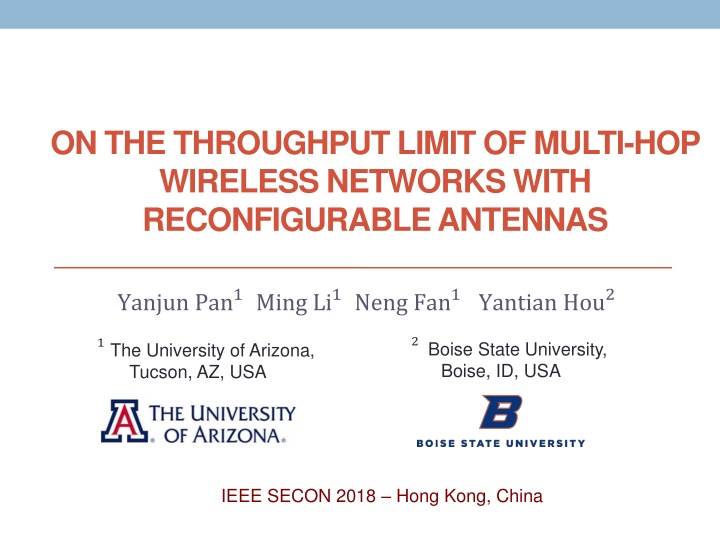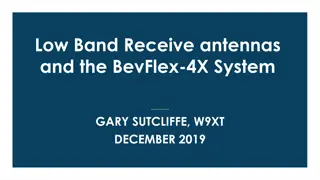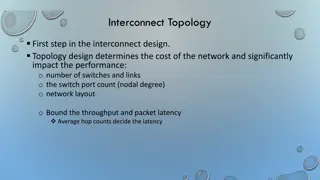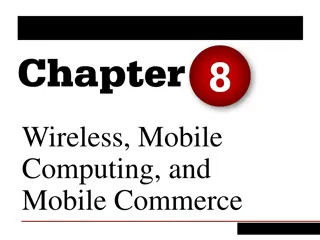Enhancing Throughput in Multi-Hop Wireless Networks Using Reconfigurable Antennas
In this study presented at IEEE SECON 2018, the authors investigate the throughput limits of multi-hop wireless networks employing reconfigurable antennas (RAs). Challenges such as unreliable links, interference, and large overhead are addressed, with existing approaches at both the link/network layer and physical layer discussed. The potential benefits of RAs, such as enhanced link capacity and reliability, interference alignment, and transmission scheduling, are explored, highlighting the potential for improved performance in multi-hop wireless networks.
Download Presentation

Please find below an Image/Link to download the presentation.
The content on the website is provided AS IS for your information and personal use only. It may not be sold, licensed, or shared on other websites without obtaining consent from the author.If you encounter any issues during the download, it is possible that the publisher has removed the file from their server.
You are allowed to download the files provided on this website for personal or commercial use, subject to the condition that they are used lawfully. All files are the property of their respective owners.
The content on the website is provided AS IS for your information and personal use only. It may not be sold, licensed, or shared on other websites without obtaining consent from the author.
E N D
Presentation Transcript
ON THE THROUGHPUT LIMIT OF MULTI-HOP WIRELESS NETWORKS WITH RECONFIGURABLE ANTENNAS Yanjun Pan1Ming Li1Neng Fan1Yantian Hou2 2Boise State University, Boise, ID, USA 1The University of Arizona, Tucson, AZ, USA IEEE SECON 2018 Hong Kong, China
Multi-hop Wireless Networks (MWNs) Sensor networks, [Keshtgari11] D2D networks, [Kar17] Mesh network for IoTs, [Annie15] UAV system, [Zhu17]
Multi-hop Wireless Networks (MWNs) Challenges unreliable links D large overhead A C unreliable Slot 1 Slot 2 Slot N B Slot N+1
Multi-hop Wireless Networks (MWNs) Challenges interference D collision A C B
Existing Approaches Link/Network Layer Mechanisms Multipath routing, e.g. [Ganesan01],[Marina01], [Mueller04], etc. Path diversity overall E2E delivery reliability Opportunistic routing, e.g. [Biswas05],[Chachulski07],[Zeng08], etc. Broadcast nature unreliable links Network coding, e.g. [Li03],[Katti06,07,08], etc. Broadcast nature & in-network processing turn interference into info. None of them touch the fundamental characteristics of the wireless channel limited gains
Existing Approaches Physical Layer Techniques Transmission power & rate control, e.g. [Cruz03],[Lin04], [ElBatt04], [Krunz04],[Chiang05] etc. Higher resource consumption, e.g. energy MIMO, e.g. [Bhatia07],[Liu08],[Chu09],[Liu10],[Blough11] etc. Spatial multiplexing & interference cancellation concurrent transmissions between multiple links possible Extra hardware & energy consumption (multiple antennas) Rich scattering might not be satisfied
Reconfigurable antennas (RAs) Dynamically Reconfigurable Properties Changing structure electronically: swiftly reconfigure in terms of radiation pattern, polarization, and frequency, or combinations of them Benefits significant reduction in size: one RA can replace multiple traditional antennas provide additional degrees of freedom Existing work shown to enhance link capacity and reliability, achieve better interference alignment and transmission scheduling, e.g. [Piazza10],[Kumar14], [Gou11], [Anderson14] exploration of RAs has been limited to single-link or single-hop networks, e.g. [Gulati14], [Yllmaz15] potential to enhance performance in MWNs has not been fully explored yet
Reconfigurable antennas (RAs) Benefits to MWNs (a) Benefit of state diversity Challenges Large number of antenna configurations available at each node Each antenna state associates with different transmission & interference range network topology become dynamic & change over time (b) Benefit of fast state switching
Interference & Antenna Model For state-link pair ?,?,?,? with transmission set ??,?, interference set ?,?: Node ? under state ? is in ??,? if ??? > ??, ??: detection threshold Node ? under state ? is in ?,? if ??? > ??, ??: interference threshold Receiver ? s received power is ??? = ??? ??,??(?,?) ??? : ? s transmission power, ??,?: path loss ?(?,?): impacts of antenna s states on the channel only pattern reconfigurable: ? ?,? = ????,??,? ????,??,? only polarization reconfigurable & both polarizations are linear: ? ?,? = ??????cos2? only frequency reconfigurable:? ?,? = ??????, if ?&? have the same frequency, otherwise, ? ?,? = 0 Supports arbitrary types of antennas
Interference & Antenna Model State-link pairs ?,?,?,? and ? ,? ,? ,? cannot transmit simultaneously if they interfere with each other Scenarios cause interference: A node selects more than one state at a certain time A node transmits to/receives from multiple nodes at a certain time A node transmits & receives at the same time The receiver of one state-link pair is interfered by another state-link pair s transmitter
Antenna State-Link Conflict Graph transmitting antenna pattern reconfigurability only Captures relations between antenna state selection, link coverage, and interference Reduces the number of combinations in the network (state-node state-link) Conflict Graph Traditional State-link Independent Sets {ab},{bd},{ac},{cd} {ab1,cd1},{ab1,cd2},{ab2,cd1},{ab2,cd2}, {ac2,bd2},{ac2,bd3},{ac3,bd2},{ac3,bd3}
Max-Flow Based Optimization Framework Scheduling Constraints: =1, if link (?,?) under state (?,?) is in independent set ? =0, otherwise Flow rate of session ? over link (?,?) under state (?,?) Capacity of link (?,?) under state (?,?) Time-share that independent set ? is scheduled Set of all the independent sets in the conflict graph
Max-Flow Based Optimization Framework Routing Constraints (flow balance): Total flow rate of session ?
Max-Flow Based Optimization Framework Primal Problem: Challenges: Find all the independent sets in a graph is NP-hard Cannot solve PP directly
Decomposition: Column Generation Based Approach In large-scale linear programming problems, most of the variables are non-basic and assumed to be zero in the optimal solution when solving the problem Only a subset of variables need to be considered Generate only the variables which have the potential to improve the objective function In our case: most of independents sets are not activated
Decomposition: Column Generation Based Approach Starting with a subset of all the independent sets ? , scheduling constraints are restricted to: Restricted master problem: Linear programming, can be solved optimally in polynomial time when given ?
Decomposition: Column Generation Based Approach Subproblem: find a new independent set Dual solution of constraint (6) Dual solution of constraint (7) =1, if link (?,?) under state (?,?) is in independent set ? =0, otherwise Optimal: ? 0 maximum weight independent set problem, NP-hard
Heuristic & Optimal Algorithms Conflict-Graph Pruning Based Heuristic Algorithm (CPH) Step 1: find link-disjoint paths Basic idea: prune the original conflict graph reduce the size of the input to the column generation based solution Aggregate all For each session: set ???= 1 Max-flow alg. Conflict graph ?? Link-disjoint paths = (? ,? ) Step 2: select top-k antenna states for each link Why link-disjoint paths? preliminary results: most of activated state-link pairs are link-disjoint reduce No. of links (??? increasing order For each ?,? ?? , sort (??? ?? Reserve ??? with largest top k (??? ?? ? , ??/?(??? For each ??? ??) = ??? ??) with non- ??) ??) Aggregate all Conflict graph ?? = (? ,? )
Heuristic & Optimal Algorithms Optimal Algorithm (RedOpt) Start with the set of independent sets obtained by CPH alg. Solve column generation structure based on the original conflict graph The running time is largely reduced comparing with original column generation based approach
Evaluation Results A Case Study Configuration 20 nodes 60m*60m area Transmitting antenna state reconfigurability only At most 100 antenna states 2 sessions: 4 18, 15 2 K=10 Platform MATLAB with CPLEX 12.7.1 Windows machine with 32GB RAM, Intel Core CPU 3.6GHz
Evaluation Results A Case Study 4 18,15 2 Node 15: State diversity & swift pattern switching
Evaluation Results A Case Study Increase dramatically Increase much slower Small gap CPH might be able to approximate to the optimal solution with high accuracy Memory overflow: no solution Lower bound
Evaluation Results Performance of Heuristic & Optimal Algorithms Impact of No. of sessions Randomly generate sessions, 10 scenarios for each session setting No. of antenna states = 40 High approximation accuracy for CPH Alg.
Evaluation Results Performance of Heuristic & Optimal Algorithms Impact of No. of antenna states Fairness issues select 10 scenarios that both sessions can be activated No. of sessions = 2 CPH performs better in random session cases good performance in general
Conclusion & Future Work Proposed a novel state-link conflict graph model capturing the dynamic antenna state-link relations Developed a tractable max-flow based methodology to derive throughput limits of MWNs with RAs Proposed a conflict-graph pruning based heuristic algorithm that further accelerates the optimal solution Future work: consider fairness issues and unreliable links/channels, design efficient approximation/distributed algorithms
Evaluation Results Comparison OCGOpt: original column generation based optimal solution ?-bounded approximation algorithm, [Li15] ? = 5% Select 4 scenarios
Evaluation Results Performance of Heuristic & Optimal Algorithms Antenna state selection benefits Simulate the joint routing and scheduling optimization only: predetermine to the pattern with highest signal power Aver. approximation ratio reduces about 20% without opt. antenna state selection
Evaluation Results Performance of Heuristic & Optimal Algorithms Scalability Network density: 10/(200*200) Increase side length of the square from 200 to 1000 2 sessions 20 antenna states Randomly generate 10 scenarios each More hops Decrease of the throughput is graceful Less throughput Directivity & Coverage of RA






















